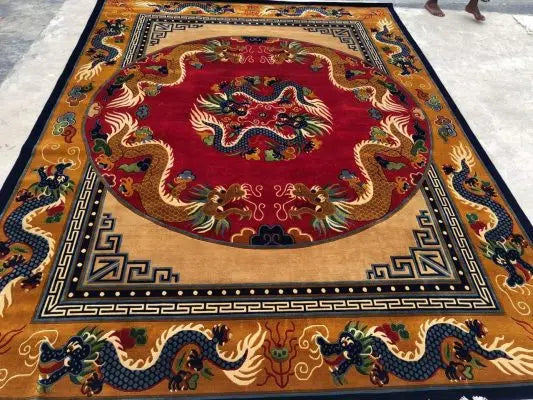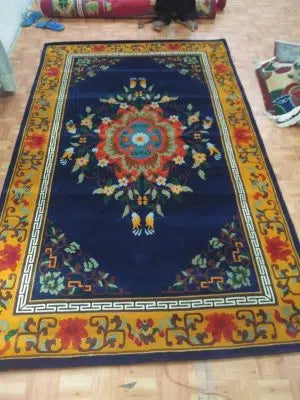
Traditional Tibetan Carpets
Traditional Tibetan carpets are renowned for their exquisite craftsmanship, intricate designs, and cultural significance. These carpets, deeply rooted in Tibetan culture and heritage, have been a symbol of beauty and tradition for centuries. This comprehensive exploration will delve into the history, materials, weaving techniques, cultural significance, designs, care, and modern adaptations of traditional Tibetan carpets, providing a thorough understanding of these remarkable textiles.
History of Traditional Tibetan Carpets
Ancient Origins
The history of Tibetan carpets dates back to ancient times, with evidence suggesting their use as early as the 7th century. The introduction of Buddhism to Tibet played a significant role in the development of carpet weaving, as the religion encouraged artistic expression and craftsmanship. Monasteries became centers of learning and creativity, where the art of carpet weaving was nurtured and refined.
Development Over Centuries
Over the centuries, Tibetan carpet weaving evolved, incorporating influences from neighboring regions such as China, India, and Persia. Trade routes facilitated the exchange of materials and techniques, enriching the Tibetan weaving tradition. Despite these influences, Tibetan carpets retained their unique characteristics, distinguished by their bold colors, symbolic patterns, and the use of high-quality wool.
Materials Used in Traditional Tibetan Carpets
Wool
The primary material used in traditional Tibetan carpets is wool, sourced from sheep raised in the high-altitude regions of Tibet and the Himalayas. This wool is prized for its softness, durability, and natural resilience. The harsh climate and rugged terrain contribute to the high quality of the wool, which is ideally suited for carpet weaving.
Natural Dyes
Traditional Tibetan carpets are often dyed using natural dyes derived from plants, minerals, and insects. Common sources of natural dyes include indigo for blue, madder root for red, and walnut husks for brown. These dyes produce vibrant, long-lasting colors that enhance the beauty and authenticity of the carpets.
Weaving Techniques
The Tibetan Knot
The Tibetan knot is a distinctive weaving technique that sets Tibetan carpets apart from those of other cultures. This technique involves looping the yarn around a rod and then tying a knot, creating a dense and durable pile. The knots are cut and compacted, resulting in a plush, resilient surface.
Looms and Tools
Traditional Tibetan carpets are woven on wooden looms, which vary in size depending on the dimensions of the carpet. The loom is an essential tool in the weaving process, allowing artisans to create precise, uniform patterns. Other tools include knives for cutting the knots, combs for compacting the weave, and shuttles for passing the yarn through the warp threads.
Cultural Significance
Symbolism in Designs
Tibetan carpets are rich in symbolism, with many designs reflecting Buddhist beliefs and Tibetan folklore. Common motifs include dragons, lotus flowers, and the endless knot, each carrying specific meanings. Dragons symbolize power and protection, lotus flowers represent purity and enlightenment, and the endless knot signifies the interconnectedness of all things.
Use in Daily Life
In traditional Tibetan households, carpets serve multiple purposes. They are used as seating mats, bed covers, wall hangings, and even as saddle blankets for horses and yaks. Their practicality, combined with their aesthetic appeal, makes them an integral part of Tibetan daily life.
Designs and Patterns
Traditional Motifs
Traditional Tibetan carpet designs often feature geometric patterns, floral motifs, and symbolic elements. These designs are meticulously planned and executed, with each element holding cultural and spiritual significance. The use of bold, contrasting colors adds to the visual impact of the carpets.
Modern Interpretations
While traditional designs remain popular, modern interpretations of Tibetan carpets have emerged in recent years. Contemporary designers are experimenting with new patterns, color schemes, and materials, creating carpets that blend traditional craftsmanship with modern aesthetics. These adaptations appeal to a global audience, expanding the reach and appreciation of Tibetan carpets.
Care and Maintenance
Cleaning
Proper care is essential to maintain the beauty and longevity of traditional Tibetan carpets. Regular vacuuming helps remove dirt and debris, while spot cleaning can address spills and stains. For deep cleaning, it is recommended to seek professional carpet cleaning services that specialize in delicate textiles.
Preservation
To preserve the integrity of a Tibetan carpet, it is important to avoid direct sunlight and excessive moisture, both of which can damage the fibers and colors. Rotating the carpet periodically ensures even wear, and using a rug pad can provide additional protection and cushioning.
Economic and Social Impact
Supporting Artisans
The production of traditional Tibetan carpets supports local economies and provides livelihoods for many artisans. By purchasing these carpets, consumers contribute to the preservation of cultural heritage and the continuation of traditional crafts. Fair trade practices and cooperatives play a crucial role in ensuring that artisans receive fair compensation for their work.
Global Market
The global market for Tibetan carpets has grown significantly, with increased demand from collectors, interior designers, and consumers who appreciate handmade, culturally significant textiles. This international interest has helped revitalize the industry, providing new opportunities for Tibetan weavers and promoting cultural exchange.
Modern Adaptations and Innovations
Sustainable Practices
In response to growing environmental concerns, many Tibetan carpet producers are adopting sustainable practices. This includes the use of eco-friendly dyes, organic wool, and environmentally responsible production methods. These efforts not only reduce the environmental impact but also appeal to eco-conscious consumers.
Technological Advancements
While traditional techniques remain at the heart of Tibetan carpet weaving, technological advancements have introduced new possibilities. Digital design tools allow for precise pattern planning, while modern looms can increase efficiency without compromising quality. These innovations help meet the demands of a growing market while preserving traditional craftsmanship.
Traditional Tibetan carpets are a testament to the rich cultural heritage and skilled craftsmanship of the Tibetan people. From their ancient origins and unique weaving techniques to their cultural significance and modern adaptations, these carpets embody a timeless art form that continues to captivate and inspire. By understanding and appreciating the intricacies of Tibetan carpets, we can support the artisans who create them and help preserve this valuable cultural legacy for future generations.
Regional Variations in Tibetan Carpets
Differences Across Regions
While Tibetan carpets share common characteristics, there are notable regional variations influenced by local traditions and available resources. For example, carpets woven in central Tibet may feature different motifs and color palettes compared to those from the eastern regions. These variations add to the diversity and richness of Tibetan carpet weaving.
Influence of Neighboring Cultures
The proximity of Tibet to regions such as Nepal, Bhutan, and China has led to cultural exchanges that influence carpet designs and techniques. Nepalese and Bhutanese weavers, for instance, have adopted Tibetan styles, creating carpets that blend elements from multiple cultures. This cross-cultural influence enriches the art of carpet weaving and introduces new creative possibilities.
Symbolism and Meaning in Tibetan Carpets
Buddhist Symbols
Many traditional Tibetan carpets incorporate Buddhist symbols that convey spiritual messages. The eight auspicious symbols, or "Ashtamangala," are commonly depicted. These include the parasol, conch shell, treasure vase, victory banner, dharma wheel, pair of golden fish, endless knot, and lotus flower. Each symbol represents different aspects of Buddhist teachings and serves as a reminder of the path to enlightenment.
Folklore and Mythology
Tibetan carpets also draw inspiration from local folklore and mythology. Dragons, snow lions, and other mythical creatures are popular motifs that symbolize protection, strength, and prosperity. These designs connect the carpets to the rich tapestry of Tibetan stories and legends.
The Role of Carpets in Tibetan Buddhism
Monastic Use
In Tibetan monasteries, carpets play an essential role in daily religious practices. They are used as seating mats during prayers and ceremonies, providing comfort and warmth in the cold monastic halls. The designs often reflect religious themes, enhancing the spiritual atmosphere of the space.
Ritual and Ceremony
Carpets are also used in various Tibetan Buddhist rituals and ceremonies. For example, during the construction of a mandala, carpets provide a sacred space for the intricate sand art. The use of carpets in these contexts underscores their importance beyond mere decoration, integrating them into the spiritual fabric of Tibetan life.
The Craftsmanship Behind Tibetan Carpets
Training and Skill
The art of weaving Tibetan carpets requires years of training and practice. Many weavers learn the craft from their parents or within their communities, starting at a young age. The process involves not only technical skill but also an understanding of patterns, colors, and symbolism.
Women in Weaving
Traditionally, women have played a significant role in Tibetan carpet weaving. Their contribution is crucial to the continuation of this art form. In many Tibetan communities, weaving provides women with a source of income and a means of preserving their cultural heritage. Empowering female weavers through fair trade initiatives and cooperatives is essential for sustaining the industry.
Challenges Facing the Tibetan Carpet Industry
Economic Pressures
The Tibetan carpet industry faces several economic challenges, including competition from mass-produced carpets and fluctuating demand. The high cost of natural materials and the time-intensive nature of handweaving add to the financial pressures on artisans.
Cultural Preservation
Preserving the cultural heritage of Tibetan carpet weaving in the face of modernization and globalization is another significant challenge. Efforts to document traditional techniques, provide training to young weavers, and promote the cultural value of Tibetan carpets are vital to ensuring their survival.
Collecting and Investing in Tibetan Carpets
What to Look For
When collecting or investing in Tibetan carpets, it is essential to consider factors such as the quality of the materials, the intricacy of the design, and the authenticity of the piece. Handwoven carpets made with natural dyes and traditional techniques are highly valued.
Care and Maintenance
Proper care is crucial for preserving the condition and value of a Tibetan carpet. Regular cleaning, protection from direct sunlight, and careful handling can prevent damage and maintain the carpet's beauty over time. Consulting experts for restoration and appraisal can also be beneficial for collectors.
The Future of Tibetan Carpets
Innovation and Tradition
The future of Tibetan carpets lies in balancing innovation with tradition. While modern designs and techniques can attract new audiences, preserving traditional methods and cultural significance remains paramount. Collaborative efforts between designers, artisans, and cultural organizations can foster this balance.
Sustainable Growth
Promoting sustainable practices in the production and trade of Tibetan carpets is essential for their continued success. Supporting fair trade, using eco-friendly materials, and raising awareness about the cultural and environmental impact of carpet weaving can contribute to a sustainable future for the industry.
Traditional Tibetan carpets are more than just decorative items; they are a profound expression of cultural heritage, artistic skill, and spiritual significance. From their ancient origins and symbolic designs to their role in daily life and modern adaptations, Tibetan carpets embody a rich tapestry of history and tradition. By understanding and appreciating the depth of these textiles, we can support the artisans who create them and ensure that this invaluable cultural legacy continues to thrive for generations to come.
Frequently Asked Questions
What are Traditional Tibetan Carpets?
Traditional Tibetan carpets are handcrafted rugs made using age-old techniques and high-quality wool, often featuring symbolic patterns and natural dyes.
What materials are used in making Traditional Tibetan Carpets?
The primary material is wool, sourced from sheep raised in the high-altitude regions of Tibet and the Himalayas. Natural dyes from plants, minerals, and insects are used to color the wool.
How are Traditional Tibetan Carpets made?
These carpets are woven using the Tibetan knot technique, where yarn is looped around a rod and tied into knots, creating a dense and durable pile.
What is the Tibetan knot?
The Tibetan knot is a unique weaving technique that involves looping yarn around a rod and tying a knot, resulting in a plush and resilient carpet surface.
What distinguishes Tibetan carpets from other types of rugs?
Tibetan carpets are distinguished by their unique knotting technique, high-quality wool, natural dyes, and symbolic designs rooted in Tibetan culture and Buddhism.
What designs are common in Traditional Tibetan Carpets?
Common designs include geometric patterns, floral motifs, and Buddhist symbols such as dragons, lotus flowers, and the endless knot.
How do natural dyes benefit Tibetan carpets?
Natural dyes provide vibrant and long-lasting colors that are environmentally friendly and enhance the authenticity and beauty of the carpets.
What is the cultural significance of Tibetan carpets?
Tibetan carpets are deeply embedded in Tibetan culture, often used in homes and monasteries for various purposes, and featuring designs that reflect Buddhist beliefs and folklore.
How are Tibetan carpets used in Tibetan households?
They serve multiple purposes, including as seating mats, bed covers, wall hangings, and saddle blankets, valued for both their practicality and aesthetic appeal.
How can I distinguish an authentic Tibetan carpet?
Authentic Tibetan carpets are handwoven, feature natural dyes, and often include traditional Tibetan designs and motifs. Checking for the Tibetan knot and high-quality wool can also help.
Are there modern adaptations of Traditional Tibetan Carpets?
Yes, modern adaptations include new patterns, color schemes, and the incorporation of materials like silk, blending traditional craftsmanship with contemporary design.
How do I care for a Traditional Tibetan Carpet?
Regular vacuuming, spot cleaning, avoiding direct sunlight, and using a rug pad can help maintain the carpet. Professional cleaning is recommended for deep cleaning.
How often should I rotate my Tibetan carpet?
Rotating your carpet every six months can help ensure even wear and prolong its lifespan.
What should I do if my Tibetan carpet gets stained?
Blot the stain immediately with a clean, damp cloth. Avoid rubbing the stain, and seek professional cleaning services if necessary.
Can Tibetan carpets be used in high-traffic areas?
Yes, Tibetan carpets are durable and can withstand high-traffic areas, but it's advisable to use a rug pad and rotate the carpet regularly to prevent uneven wear.





